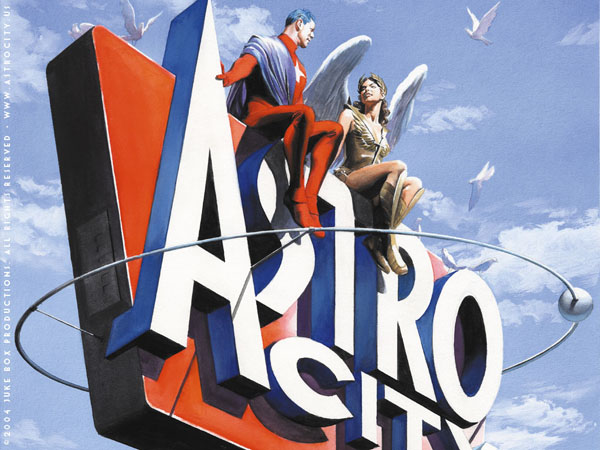
Catching up with Astro City
I can’t believe that Kurt Busiek’s Astro City is twenty years old! The series remains one of the finest superhero comic books ever created. Begun in the nineties, after a dreary decade of grim, deconstructionist superhero stories had dominated the industry — sub-par attempts to imitate the great works of Watchmen and The Dark Knight Returns from the mid-eighties — Kurt Busiek began his project to do exactly the opposite.
In his introduction to the first Astro City collected edition, Life in the Big City, Mr. Busiek himself explained his goal: “The superhero genre has historically been limited to adventure thrillers, action stories that can be sold easily to boys in their teen years or younger. But that’s a self-imposed, market-driven limitation, not any sort of creative limitation of the genre… I’ve long been fascinated by the question of what else happens in the worlds the superheroes inhabit; what life is like for the guy who points upward and declaims: ‘Look! Up in the sky!'” Mr. Busiek continues: “One thing I didn’t want to do is to take the superhero story and make it ‘realistic’ — which is odd, since that’s become the quickie shorthand description of Astro City… Well, no. No, it isn’t. We’ve got trolls living underground in Astro City. We’ve got time travelers reweaving the future. We’ve got fantastic technology, mystical creatures, alien contact and powerful, violent, destructive beings by the double handful — and in Astro City history, they’ve been around for decades, without turning the world into something unrecognizable from our own perspective… I like the absurd, unrealistic glory of the superhero genre, and I want to see it as a place of gods and aliens and super-science and talking gorillas and ordinary people like you and me, all dealing with metaphor run amok, coping not with what logical effect it all has, but with the emotional effect.” Finally, Mr. Busiek states: “For the past decade… the prevalent mode for “serious” superhero creators has been deconstruction. The superhero has been dissected, analyzed and debunked, his irrationalities held up to the light to show them for the unworkable Rube Goldberg machines they are, so that it’s almost become impossible to present a superhero who does what he does without being emotionally unstable, incapable of dealing with reality without “acting out” his psychoses and obsessions. But it strikes me that the only real reason to take apart a pocket watch, or a car engine, aside from the simple delight of disassembly, is to find out how it works. To understand it, so that you can put it back together again better than before, or build a new one that goes beyond what the old model could do. We’ve been taking apart the superhero for ten years or more; it’s time to put it back together and wind it up, time to take it out on the road and floor it, see what it’ll do. That’s the prospect that excites me, that makes me eager to tell my stories to anyone who’s willing to listen.”
For twenty years, Mr. Busiek and his incredibly talented collaborators, artists Alex Ross and Brent Anderson, have created a complex, sophisticated superhero story that appeals to adults but that is also appropriate for kids. There are very few comic book series able to thread that needle.
In Astro City, Mr. Busiek has mixed multi-part stories with shorter, one or two issue tales. Mr. Busiek is a master of the one-part story, something of a lost art in comics these days. But because these single-issue stories each illuminate and expand upon different characters and different corners of the Astro City universe, Mr. Busiek is able to achieve the best of both worlds — deeply satisfying single-issue short stories that also fit together to craft an epic, multi-generational epic saga. (And I do love sagas!!) So we get the pleasure of terrific short stories, while reading the series in order allows the reader to dive deeply into the complex, extraordinarily well thought-out world Mr. Busiek and his collaborators have created.
Brent Eric Anderson has done a lot of work around the comic book industry over the past several decades, but Astro City is his greatest achievement. Mr. Anderson is an underrated workhorse. His art isn’t very flashy, but Mr. Anderson can draw just about anything. This makes him perfect for this series, which changes focus and main characters nearly every issue. Mr. Anderson’s consistency is remarkable. Alex Ross, meanwhile, has provided breathtaking painted covers for every single issue of the series since the very beginning. Each one is a masterpiece, a dazzling gateway into the wonderful stories within. Mr. Ross’ impeccable design skills have also served the series well, as he and Mr. Anderson have collaborated with Mr. Busiek on designing the hundreds of characters, super-powered and otherwise, who populate the stories of Astro City.
The series’ achilles heel has been its inconsistent publishing schedule. This has been caused primarily by the health problems that have have unfortunately beset Mr. Busiek for years, and also by the changes in the wider comic book industry that have seen Astro City bounce around different publishers and imprints.
Fortunately, after a long hiatus, a few years ago Astro City returned to a monthly publishing schedule, something the series has (mostly) maintained for the past several years. Thank goodness!
When the series launched its latest incarnation in 2013, I read the first issue immediately and was delighted. But then I decided that, before continuing, I wanted to reread the series from the beginning. Because the publishing schedule had been so erratic, I felt my memories of the characters and story-lines needed to be refreshed, so that I could have the deepest possible enjoyment of the new issues. But then life got in the way, and while I kept buying Astro City every month, the issues remained unread. (For the past few years, when compiling my list of my favorite comic book series of the year, I commented that Astro City would have surely been on the list had I been caught up.)
Over the last month, I finally had the chance to do what I had long desired to do: re-read this series from start to finish. What a delight! I am so happy to discover not only that the early issues, from twenty years ago, were exactly as terrific as I had remembered, but also that the latest issues were every bit as great. Twenty years in, this series remains full of life and new ideas. That is extraordinary.
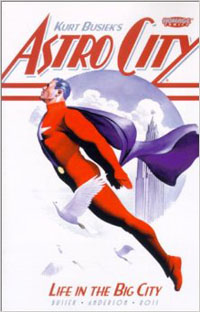
Next came the series’ first attempt at a monthly regular series. Twenty-two issues were published by Jim Lee’s Homage Comics between 1996 and 2000. These twenty-two terrific issues were a mix of new short stories and two extended multi-part tales: Confession and The Tarnished Angel.
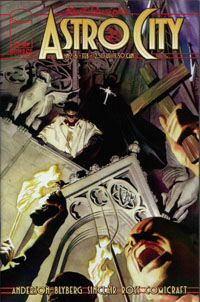
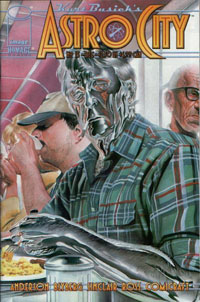
It took about two years for the seven-issue The Tarnished Angel story to come out, due to Mr. Busiek’s health problems. After a handful of additional issues, the series went on a two year hiatus. It returned with the five-issue mini-series Local Heroes.
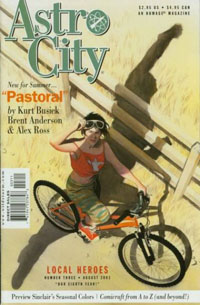
After a special one-shot highlighting the superhero Supersonic, brought out of retirement as an old but still super-powered man, and a wonderful Astro City Visitor’s Guide that highlighted different characters and locations from the series (and gave us the pleasure of seeing many of the series’ superheroic characters illustrated by many of the top comic book artists of the day), Mr. Busiek, Mr. Anderson, and Mr. Ross began the series’ longest epic: The Dark Age:
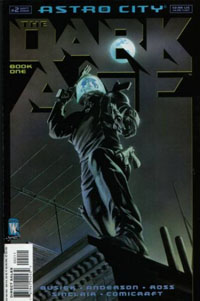
This story-line was extraordinary. I loved the development of Charles and Royal and their complicated relationship, and I loved this deep dive into the history of Astro City and so many of its characters, in specific the Silver Agent (whose mysterious fate has been hinted at since Astro City’s earliest issues). It was fascinating to see Mr. Busiek depart from the single-issue stories that he did so well to tell this extended, sixteen-part epic. The only problem, as usual, was the series’ slow production schedule, as it took from 2005 all the way until 2010 for this sixteen-issue story to reach its completion. That sorely tested my patience at the time, but reading the series all together, now, it is clear that it is a masterpiece.
Also, to give proper credit where it is due, Mr. Busiek and his team did release an additional number of one-shots, in-between the Dark Ages arcs, that were mostly set in Astro City’s “modern day” and spotlighted other characters. One of the best was “The Eagle and the Mountain,” which depicted arch enemies Samaritan and the Infidel sharing a meal together. Other terrific issues spotlighted Beautie (a Barbie-doll come to life) and the Silver Agent (at long last revealing the truth about his past and future). We also caught up with Astra, the young daughter of Astro City’s First Family (a family of superhero-scientists similar to Marvel’s Fantastic Four) who was first seen in one of Astro City‘s early stories as a tween girl and now, years later, we see her graduating from college and pondering her future. Every one of these special issues was fantastic.
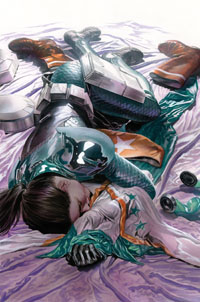
This new run of stories has been as great as the series has ever been, a remarkable feat considering that issue #26 celebrated the series’ TWENTIETH anniversary, and issue #41 was their 100th total issue published. These new issues have continued to explore new ground, spotlighting new heroes, villains, and ordinary Astro City denizens. Several characters who have been around since the series’ very beginning finally got their spotlight stories, from Winged Victory in issues #7-10 to the duo of Crackerjack and Quarrel in issues #18-21. Issue #39 finally gave us a glimpse at the origin of the enigmatic Hanged Man. Mr. Busiek had been talking about doing an Astro City talking monkey story for years, and we finally got one in issues #23-24.
I have also been pleasantly surprised by the ways in which this current run of issues has returned to characters from the earlier stories. The last issue of the original mini-series, published more than two decades ago, told the story of Samaritan and Winged Victory’s first date, and the Winged Victory spotlight in vol. 3 #7-10 caught back up with that relationship. In that same story, we also got to check in with the second Confessor, introduced way back in the early “Confession” arc from vol. 2 #4-9. Issue #3 shines a spotlight on Martha Sullivan, a woman in the movie industry with telekinetic powers who was a side character back in vol. 2 #22. We follow-up on the multi-generational history of the hero called Jack in the Box, first spotlighted in vol. 2 #11-12, in a new two-part story in #35-36. Marta, the Shadow Hill denizen spotlighted in issue #4 of the original Astro City mini-series, returns in issues #39-40. We even get a sequel to my very favorite Astro City story-line, “The Tarnished Angel,” when we check back in with Steeljack, now a licensed P.I., in issues #32-34.
The biggest change to this new run is that, for the first time since the beginning, Brent Eric Anderson has not been the series’ sole illustrator. Various guest artists have rotated in for single issues or multi-part story-lines. I’m frankly torn about this. Clearly the use of guest artists has allowed this latest volume to be published more frequently than previous installments, and anything that means more new Astro City comics is good news. But on the other hand, Mr. Anderson’s style is indelibly linked with Astro City in my mind. Any issue not drawn by him just doesn’t quite feel like “real” Astro City to me. When the guest artist is strong (such as Graham Nolan in #12, Carmen Carnero in issues #39-40, and Jesus Merino in #22, 25 & 31), I am OK with this. But when the guest artist is weak (the less said about issue #27 the better), I’d rather have waited another month or three for Mr. Anderson.
In a more successful change, while Mr. Busiek has continued his admirable focus on short-stories, this new monthly series has also seen Mr. Busiek’s first attempt to bring an over-arching, long-running sub-plot story into Astro City. The very first issue of this new run introduced a mysterious character called the Broken Man, and a hidden threat tied to Astro City’s history. The Broken Man has popped up several times in the subsequent forty-plus issues, but we’re not much closer to understanding the nature of this character or the enemy he’s been warning us about. I love this slow-burn mystery, and the way it adds a new flavor to the book, while also allowing us to explore never-before-seen corners of the city’s long history. I am impressed that Mr. Busiek has been able to keep this story-line going for forty-plus issues, and I can’t wait to see where this is all heading.
Astro City is a remarkable achievement. It was one of my very favorite comic books more than twenty years ago, and it remains so today.
Check it out yourself: start at the very beginning with Life in the Big City and go from there. You’re welcome.
